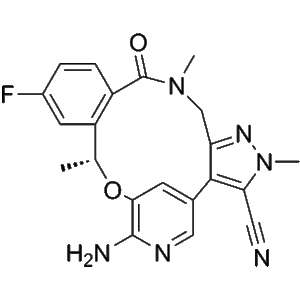No products in the cart.
Lorlatinib (Lorbrena) 25mg 100mg Guide: Uses, Dosage, Side Effects & FAQs
Contents
hide
Introduction
Lorlatinib, also known by its brand name Lorbrena, is a third-generation tyrosine kinase inhibitor (TKI) designed to treat ALK-positive non-small cell lung cancer (NSCLC) and ROS1-positive NSCLC. Unlike earlier generations of ALK inhibitors, this medication is effective against a broad spectrum of resistant mutations and demonstrates significant penetration into the central nervous system (CNS), which benefits patients with brain metastases.
This guide provides a detailed overview of Lorlatinib’s pharmacology, clinical trial evidence, dosage recommendations, safety profile, and frequently asked questions. It is intended for educational purposes and should not replace medical consultation.

1. Pharmacology and Mechanism of Action
Lorlatinib is a potent inhibitor of ALK and ROS1 tyrosine kinases, which play a key role in tumor cell proliferation in ALK-rearranged lung cancer. Key pharmacological aspects include:
Broad ALK Mutation Coverage
Many patients develop resistance to first- and second-generation ALK inhibitors.
Lorlatinib overcomes mutations such as G1202R, L1196M, and other solvent-front mutations.
The drug binds strongly to the ATP-binding pocket, ensuring sustained inhibition of aberrant kinase activity.
Blood-Brain Barrier Penetration
CNS metastases occur in a significant fraction of ALK-positive NSCLC patients.
Lorlatinib crosses the blood-brain barrier effectively, achieving therapeutic concentrations within the CNS.
Clinical studies show intracranial response rates up to 82%.
Selective Kinase Inhibition
Minimizes off-target activity to reduce toxicity.
Compared to crizotinib and alectinib, Lorlatinib demonstrates higher selectivity and durability.
Pharmacokinetics
Oral administration, once daily.
Metabolized primarily via CYP3A4; dose adjustments may be needed when combined with strong CYP3A modulators.
2. Clinical Trial Evidence
CROWN Phase III Study
Design: Randomized, open-label, comparing Lorlatinib with Crizotinib in treatment-naive ALK-positive NSCLC.
Endpoints: Progression-free survival (PFS), overall survival (OS).
Results:
Median PFS: Not reached vs 9.3 months (Crizotinib)
Overall response rate (ORR): 76% vs 58%
Intracranial ORR: 82% vs 23%
Conclusion: Lorlatinib is superior in systemic and CNS efficacy.
Post-TKI Resistance Studies
Patients resistant to prior ALK inhibitors achieved ORR 39–47%, intracranial ORR ~66%, confirming activity in resistant mutations.
3. Dosage and Administration
Recommended Dose: 100 mg orally once daily.
Administration: Can be taken with or without food, at the same time each day.
Dose Adjustments:
For hepatic or renal impairment
For strong CYP3A modulators
For adverse events management
Missed Dose Guidance:
If <4 hours late, take immediately
If near next dose, skip; do not double
4. Safety Profile and Adverse Effects
Lorlatinib is generally well-tolerated. Most frequent adverse events include:
Peripheral edema
Hypercholesterolemia and hypertriglyceridemia
Weight gain
Cognitive effects: memory or speech changes
Mood alterations: depression or anxiety
Fatigue and neuropathy
Management:
Dose adjustment or temporary interruption
Lipid-lowering therapy if needed
Supportive care for cognitive and neurological symptoms
5. Patient Selection and Contraindications
Ideal Candidates:
ALK-positive NSCLC, including patients previously treated with other ALK inhibitors
Patients with CNS metastases
Contraindications:
Pregnancy and breastfeeding
Severe liver impairment
Concomitant strong CYP3A inhibitors/inducers
Special Populations:
Elderly: monitor fluid retention and cognition
Pediatric: limited data
Cardiac risk: ECG recommended
6. Real-World Evidence
Case studies demonstrate durable responses in both treatment-naive and post-TKI resistance patients.
Example: Patient with G1202R mutation achieved partial response for 24 months.
CNS metastases respond rapidly, often within 6–8 weeks.
7. Extended FAQ (15–20 Questions)
Q1: What is Lorlatinib used for?
A: ALK-positive or ROS1-positive NSCLC, including resistant cases.
Q2: Can Lorlatinib cure lung cancer?
A: No, it improves survival and delays progression.
Q3: How long should treatment continue?
A: Depends on response; some patients continue for years.
Q4: Can Lorlatinib be taken with food?
A: Yes.
Q5: Common side effects?
A: Edema, weight gain, hyperlipidemia, cognitive changes, neuropathy.
Q6: How effective is it for brain metastases?
A: High intracranial ORR (~82%).
Q7: Dose adjustments needed?
A: For adverse events or drug interactions.
Q8: Can it be combined with other therapies?
A: Only in clinical trials or specialist supervision.
Q9: How is liver function monitored?
A: Baseline labs and periodic monitoring.
Q10: Can it be used during pregnancy?
A: No, contraception required.
Q11: What drugs interact with Lorlatinib?
A: Strong CYP3A inhibitors/inducers.
Q12: How soon do responses occur?
A: 1–2 months on average.
Q13: How is cognitive toxicity managed?
A: Dose reduction, interruption, supportive care.
Q14: Is weight gain reversible?
A: Usually manageable with diet and dose adjustment.
Q15: Is long-term safety acceptable?
A: Yes, with ongoing monitoring.
Q16: Are there insurance considerations?
A: Varies by region; consult provider.
Q17: Can Lorlatinib be used in children?
A: Limited data; specialist guidance required.
Q18: Can therapy be stopped after remission?
A: Typically continued until progression; consult oncologist.
8. Disclaimer
Educational purposes only. Not a substitute for medical advice. Consult a healthcare provider before starting, adjusting, or stopping Lorlatinib.
References:
Lorlatinib dosage →
/lorlatinib-dosageALK TKI overview →
/alk-tki-overview

